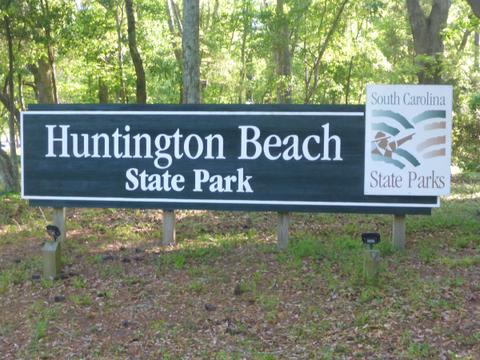
Huntington Beach State Park
Huntington Beach State Park
Murrells Inlet, South Carolina 29576
Official WebsiteHuntington Beach State Park brochure and map
Tips for Birding
When submitting eBird observations at Huntington Beach State Park, it is most helpful to start a new checklist for each hotspot in the park. Use the general hotspot when you have a checklist that includes multiple locations or if no other hotspot or personal location is appropriate for your sightings.
Huntington Beach State Park is considered by many to be the best birding spot in South Carolina, anytime of year. Although you may not expect it, wintertime can yield some of the best sightings of all.
As you enter the park, you will pass over the causeway: to your right is a managed freshwater marsh impoundment known as Mullet Pond, to your left are the tidal salt marshes of Murrells Inlet. At the end of the causeway to your right is a parking lot. Leave your car here and walk back along the sidewalk for a closer look.
Birds of Interest
View and print the state park detailed birding checklist of over 300 species that have been seen within park boundaries.
If you are fortunate enough to see one of these birds, please report your sighting (and the band information) to the park’s Education Center. Here, you can also check the log book to see what other birders have been seeing lately or post your own sightings. Also take advantage of one of the many birding programs the park offers throughout the year.
About this Location
A pristine Grand Strand beach encompassing Atalaya, the National Historic Landmark winter home of Archer and Anna Hyatt Huntington, makes Huntington Beach State Park one of South Carolina’s most recognizable landmarks. Relax with a sea breeze off the Atlantic Ocean while camping, enjoy some of the finest surf fishing South Carolina has to offer, and experience some of the top bird-watching on the East Coast. Choose from a variety of programs throughout the year that offer an educational and fun experience. Alligators also call Huntington Beach State Park’s freshwater ponds home, giving
visitors the opportunity to view these unique animals in their native habitat.
In addition to three miles of beach, much of the park is salt marshes, one of the world’s most productive ecosystems. Much of Huntington Beach’s marsh is now registered under the South Carolina Heritage Trust Program to help preserve its unusually pristine nature.
Notable Trails
Kerrigan Nature Trail. 0.3 miles, Easy
From the parking area, it is an easy 0.2-mile walk to an observation deck over the brackish water impoundment of Mullet Pond, where you may see a variety of shorebirds and wading birds. For a longer hike, this trail intersects the historic driveway of Atalaya Castle. Turn right to see the causeway that divides the freshwater Mallard Pond from Mullet Pond. Turn left to return to the parking lot along the park roads. Spring and summer offer great views of nesting anhingas, green and tricolor herons, and common gallinules; wood storks, roseate spoonbills, and swallow-tailed kites may also be seen. Ducks are prominent in the winter. Other wildlife to be seen includes alligators, turtles, bullfrogs, and deer.
Sandpiper Nature Trail, 2.0 miles, Easy
This easy 2-mile out-and-back trail meanders through a maritime forest of ancient dunes covered in oaks, pines, and cedars. The Maxwell Observation Deck offers viewing of a wide array of wading birds and alligators, ducks in winter, and shorebirds on migrations.
For a longer hike (+ round trip of 2.5 miles), continue north on the beach to the jetty. One of a pair that holds Murrells Inlet in place, it also serves as a rocky coastline where one would not normally exist. Visitors can walk out across the ocean to view a variety of rare seabirds and sea ducks in the winter, swimming juvenile sea turtles during the summer, and mink and dolphins year-round.
Content from Official Website
Last updated May 6, 2024







